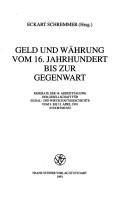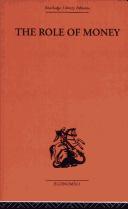| Listing 1 - 10 of 155 | << page >> |
Sort by
|
Book
ISBN: 0678055475 Year: 1970 Publisher: New York, A. M. Kelley,
Abstract | Keywords | Export | Availability | Bookmark
 Loading...
Loading...Choose an application
- Reference Manager
- EndNote
- RefWorks (Direct export to RefWorks)
Currency question --- -Currency question --- -Fiat money --- Free coinage --- Monetary question --- Scrip --- Currency crises --- Finance --- Finance, Public --- Legal tender --- Money --- History --- Fiat money --- History.
Book
ISBN: 0873412079 Year: 1994 Publisher: Iola : Krause,
Abstract | Keywords | Export | Availability | Bookmark
 Loading...
Loading...Choose an application
- Reference Manager
- EndNote
- RefWorks (Direct export to RefWorks)
Paper money --- -332.404403 --- Fiat money --- Currency question --- Inflation (Finance) --- Money --- Bills (Paper money) --- Paper currency
Book
ISBN: 1606497472 Year: 2014 Publisher: New York, New York (222 East 46th Street, New York, NY 10017) : Business Expert Press,
Abstract | Keywords | Export | Availability | Bookmark
 Loading...
Loading...Choose an application
- Reference Manager
- EndNote
- RefWorks (Direct export to RefWorks)
The premise of the author is that the study of money should commence at the most general level. Consequently, the book is anchored in the context of monetary systems (commodity, fiduciary, and fiat monies). The intent is to give the student of money a very broad perspective. It allows them to understand, for example, how the money we use today differs from money used in the past, or how our current money relates to money discovered by anthropologists in isolated subcultures.
Book
ISBN: 1606498215 Year: 2015 Publisher: New York, New York (222 East 46th Street, New York, NY 10017) : Business Expert Press,
Abstract | Keywords | Export | Availability | Bookmark
 Loading...
Loading...Choose an application
- Reference Manager
- EndNote
- RefWorks (Direct export to RefWorks)
Foreign exchange markets are inextricably entwined with underlying monetary standards. Thus, they are treated conjointly. Four different exchange rate regimes are analyzed: (1) foreign exchange markets with commodity money; (2) foreign exchange markets with fiduciary money; (3) foreign exchange markets with fiat money--fixed exchange rates; and, (4) foreign exchange markets with fiat money--flexible exchange rates. For the last eight decades, most countries have operated with fiat monies. For proponents of the fiat money standard, one of its desirable attributes is that it provides individual countries with considerable monetary autonomy. However, both analytics and experience indicate that this is not always the case. Whether a country has more monetary autonomy depends upon whether fiat money is paired with fixed exchange rates (regime 3) or flexible exchange rates (regime 4). More autonomy is possible with flexible exchange rates (regime 4). Such autonomy is largely possible because foreign exchange markets are allowed to accommodate the wide variations in national monetary policies. Under this regime, the purchasing power parity (PPP) theory of exchange rates assumes elevated importance in accounting for foreign exchange market adjustments. Exchange rate regime 4 has been in place (in many countries) for more than four decades, and there are critics. Those who advocate scrapping this arrangement generally favor a return to either regime 2 or regime 3.
Foreign exchange market. --- Foreign exchange rates. --- central banking --- commodity money --- deflation --- fiduciary money --- fiat money --- fixed exchange rates --- flexible exchange rates --- inflation --- purchasing power parity

ISBN: 3515062203 Year: 1993 Publisher: Stuttgart Steiner
Abstract | Keywords | Export | Availability | Bookmark
 Loading...
Loading...Choose an application
- Reference Manager
- EndNote
- RefWorks (Direct export to RefWorks)
Money --- -Currency question --- -Fiat money --- Free coinage --- Monetary question --- Scrip --- Currency crises --- Finance --- Finance, Public --- Legal tender --- Currency --- Money, Primitive --- Specie --- Standard of value --- Exchange --- Value --- Banks and banking --- Coinage --- Currency question --- Gold --- Silver --- Silver question --- Wealth --- History --- -Congresses --- Congresses. --- -History --- Congresses --- Fiat money --- History&delete&
Book
ISBN: 0806113383 0806113391 9780806113395 9780806113388 Year: 1976 Publisher: Norman (Okla.): University of Oklahoma press,
Abstract | Keywords | Export | Availability | Bookmark
 Loading...
Loading...Choose an application
- Reference Manager
- EndNote
- RefWorks (Direct export to RefWorks)
monnaie --- geld --- -Geld. Geldwezen. Monetaire sector. --- -Fiat money --- Currency question --- Money --- 336.74 --- Fiat money --- Free coinage --- Monetary question --- Scrip --- Currency crises --- Finance --- Finance, Public --- Legal tender --- 336.74 Geld. Geldwezen. Monetaire sector. --- Geld. Geldwezen. Monetaire sector. --- History --- Geld. Geldwezen. Monetaire sector --- Money - History
Book
ISBN: 9026804202 Year: 1970 Publisher: Deventer
Abstract | Keywords | Export | Availability | Bookmark
 Loading...
Loading...Choose an application
- Reference Manager
- EndNote
- RefWorks (Direct export to RefWorks)
Money. Monetary policy --- Sociology of the developing countries --- Financial law --- Theses --- Currency question --- Fiat money --- Free coinage --- Monetary question --- Scrip --- Currency crises --- Finance --- Finance, Public --- Legal tender --- Money --- History
Book
ISBN: 2863770128 Year: 1981 Publisher: Paris : Léopard d'or,
Abstract | Keywords | Export | Availability | Bookmark
 Loading...
Loading...Choose an application
- Reference Manager
- EndNote
- RefWorks (Direct export to RefWorks)
Assignats. --- Paper money --- History --- FR / France - Frankrijk --- 331.154 --- XVIIe, XVIIIe eeuw. Fysiocratie. --- Assignats --- Bills (Paper money) --- Fiat money --- Paper currency --- Money --- Inflation (Finance) --- XVIIe, XVIIIe eeuw. Fysiocratie --- Numismatics
Book
ISBN: 0631184406 9780631184409 Year: 1977 Publisher: Oxford: Blackwell,
Abstract | Keywords | Export | Availability | Bookmark
 Loading...
Loading...Choose an application
- Reference Manager
- EndNote
- RefWorks (Direct export to RefWorks)
International finance --- Currency question. --- systeme monetaire international --- internationaal monetair systeem --- Currency question --- International monetary system --- International money --- Finance --- International economic relations --- Fiat money --- Free coinage --- Monetary question --- Scrip --- Currency crises --- Finance, Public --- Legal tender --- Money

ISBN: 0415488915 1317833538 1315823993 1317833546 0415313945 130657529X 9781317833536 9781315823997 9780415313940 9780415488914 9781317833543 9781317833529 Year: 2003 Publisher: London
Abstract | Keywords | Export | Availability | Bookmark
 Loading...
Loading...Choose an application
- Reference Manager
- EndNote
- RefWorks (Direct export to RefWorks)
The Role of Money examines the mystery of money in its social aspect and illustrates what money now is, what is does and what it should do. The standpoint from which the book is written is that of the public. The significance of the 'money-power' of the state to issue money has been recently recognized by historians. Its key position in shaping the course of world events is here explained. Included are:* Chapters on the philosophic background* The theory of money - Virtual Wealth* The Evolution of Modern Money* International Economic Relations* Debts and De
Money. --- Currency question. --- Fiat money --- Free coinage --- Monetary question --- Scrip --- Currency --- Money, Primitive --- Specie --- Standard of value --- Currency crises --- Finance --- Finance, Public --- Legal tender --- Money --- Exchange --- Value --- Banks and banking --- Coinage --- Currency question --- Gold --- Silver --- Silver question --- Wealth
| Listing 1 - 10 of 155 | << page >> |
Sort by
|

 Search
Search Feedback
Feedback About UniCat
About UniCat  Help
Help News
News